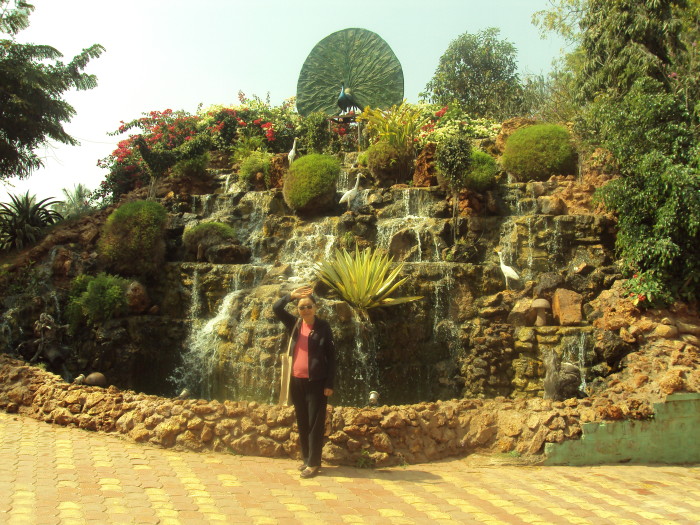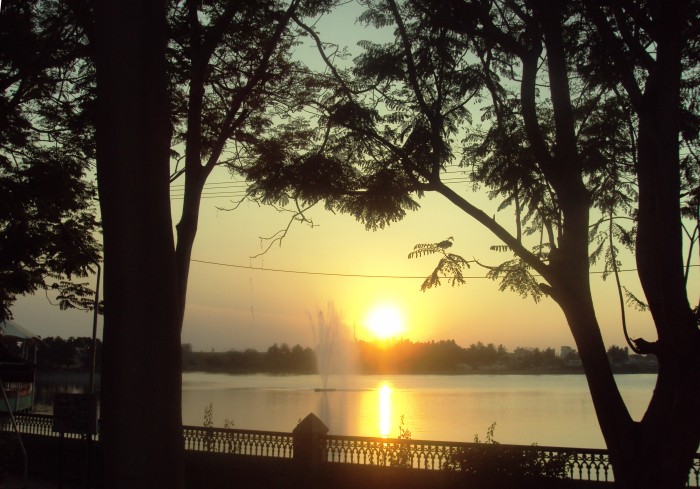Those who are passionate about karate would probably want to learn and practice it in Okinawa, Japan, and those who love yoga might dream to fly to India for the first-hand experience. I felt a strong attraction to both disciplines and had planned to travel to each of those countries for some time. When one of my colleagues, who was originally from India, told me about the Jindal Institute of Naturopathy and Yogic Sciences (JNI), I decided to make it my first destination. Last February, I finally had the chance to travel there and to stay at the Institute for three weeks learning and living yoga.
Upon first visiting, one gets the impression that India is a country of extremes, with five star luxury hotels and flashy artifacts of the nouveau riche on one side and poor villages and slums on the other. JNI is located near Bangalore or Bengaluru, the capital of the state of Karnataka. After spending a few days at Bengaluru which appeared to be a huge construction site for building a new transportation system of the city, I saw a green and serene oasis with coconut trees and flowerbeds all over the grounds and dancing fountains rising from the water and falling back at the Jindal Institute.
Prior to my trip I associated yoga mostly with instructor-led classes and meditation. At JNI, I learned that postures are important, but they are only a part of yoga. Yoga must be a way of life, a natural way of better living every day. It is also defined as “a practical system of self culture that brings peace and harmony in life,” or a system that provides the practical tools to help us in striving for peaceful and harmonious existence, i.e. yogic living.
In this context, yoga should be practiced throughout the entire day in a proper sequence. A day at JNI started very early with yogic cleansing called kriyas that was done under the supervision of instructors. Through yogic kriyas the body is prepared for yoga practices by opening the channels for spiritual reception. Cleaning the intestine, nose, mouth, throat and eyes is needed to feel lighter, breathe better and to revitalize the vision. I was prescribed ghee drops to lubricate the nose, steam inhalation with a little of eucalyptus oil dabbed inside the nostrils, neti (jalaneti) which is nasal cleansing with salt water using a neti pot, gargling with hot salt solution, and eye wash with special cooling tonic water using eye cups.
All kriyas procedures made me feel refreshed and “clean”; in fact, and I found them very effective, so much so that they are now part of my yogic living routine. On the other hand, “laughing sessions,” ten minutes of induced practice of laughter to change a “grumpy” mind to be happy felt rather awkward to me at the beginning. Nevertheless, looking around at the people trying to laugh like children helped me to pick up their example.
There was no breakfast at JNI as yoga should be always practiced on an empty stomach. Yoga sessions are not only postures as they are composed of chanting, asanas, pranayama and meditation. All parts of the yoga sessions were designed for connecting mind and body. I learned new ways of om chanting and more ways of controlling breath; I also learned cosmic meditation and the fact that asanas are different from exercises not only because they are performed slowly, but because they restore energy and peace of mind instead of taking energy for burning calories and building the body. Not only is the sequence of asanas devised to benefit specific areas of body, it is crucial to perform them correctly according to their purpose, either in a continuous motion or relaxed and focusing the mind on each movement.
Just as important as asanas were mudras (gestures) and nidra (relaxation). Mudras control the energy of life force like in tai chi and it’s important to pay attention to the movements of fingers, hands, arms and other gestures of the body. Mudras were taught in conjunction with pranayama and asanas. The afternoon nidra sessions were my favorites. Being in Shavasana with closed eyes and gradually relaxing all parts of the body from the first chakra to the top–surrendering to the instructions and not moving at all–was in a word, blissful.
Unlike the other familiar kinds of meditation with mantras and breath work, cosmic meditation was a discovery to me. It was just enjoyable, relaxing, and non-resistant, because there was no need to discipline the mind by repeating mantras and controlling breath. On the contrary, breathing is normal to begin with, then becomes slower, quieter and shallow, diminishing to a dot and moving onto the “third eye” spot–this is is now a permanent part of my meditation practice.
Yogic living as a healthy way of life is also about natural food. Only vegan plant-based food was served at JNI and juice fasting was used for detoxification. I was amazed to find out how many naturopathic treatments existed and were offered at the Jindal Institute of Naturopathy and Yogic Sciences. But at the end of my stay, it was not how much (or how little) I learned about yogic living that changed me, but rather how much awareness and self-awareness I acquired and how much this awareness inspired me to be better and live better. I know now that I like to live slowly, silently and serenely. I like to jog early in the morning in my neighborhood of Williamsburg, Brooklyn, to greet the sunrise and to watch the bright sun slowly rising across the East river and radiating its rays over Manhattan with the similar emotion of wonder that I had while jogging at JNI and watching a beautiful sunrise in India. I believe the sun will rise equally beautifully in Japan when I fly there to practice karate in the “Land of the Rising Sun.”
More in Travel: Photo Essay – New England Charm, Hiking, and Apple Picking in Connecticut
Dispatch – Vegan in Guatemala, the Kaleidoscope of Central America
Also see: The Rainbow Connection – Your Chakra System and You
How to Find the Right Yoga for You
___
Photo: Larisa Tazmin






